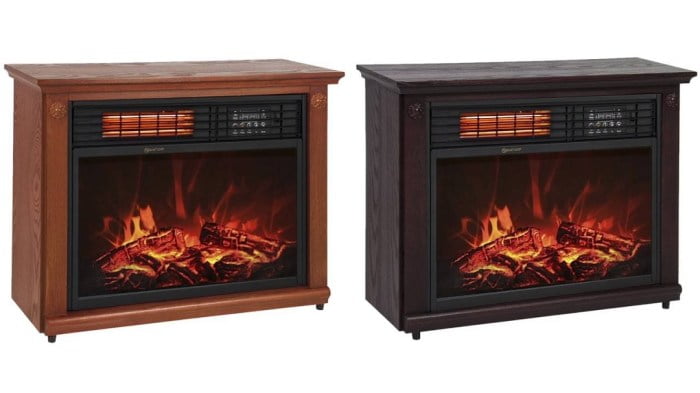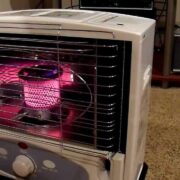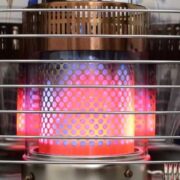If you have been looking for an alternative to your traditional heater, then infrared heaters may be the answer. they are a fantastic way to keep you warm during the cold winter months. But what are they? Infrared heaters are one of the latest heating technologies to hit the market.
You may not know the benefits of infrared heaters, but you cannot deny they are a popular option. You might be interested to learn that there is much more to them than what meets the eye. Infrared heating works by converting electricity into thermal energy that radiates off the source and heats up anything in its path.
This means that it is not only more efficient but has some other benefits as well. In this article, we will discuss what infrared heating is and how it works, its pros and cons and What is the difference between infrared and other types of heat? so you can decide if it would work for you!
[amazon box=”B01834FBAS”]What Is an Infrared Heater and How Does It Work?
An infrared heater emits electromagnetic waves with an invisible wavelength, in the form of infrared light into your room. The heat from the infrared waves is then absorbed by any object in its path. This means that it heats up objects rather than blowing hot air around as a fan heater does.
Infrared heaters are made with elements and cables which emit infrared light when electricity passes through them, this creates an electromagnetic wave within the system of wires conveying electrical energy to a resistor. This is then converted into heat and emits infrared waves which are invisible to the naked eye, like a black-body radiator.
This radiant heating method differs from convection heating as it only heats objects in its path rather than blowing hot air around like a fan heater would. The result of this means that it is more efficient because it is not required to produce hot air which heats up the surrounding area. This means that it can only heat one room at a time, but you will also get more direct heating as well.
Infrared heaters use either ceramic vs infrared vs quartz heaters emitters and work on convection principles for them to function properly and effectively. The difference in an infrared heater and a normal fan-based heater is that it uses invisible light waves rather than hot air to heat up the room.
Infrared Heater Pros & Cons (Including Safety, Cost, Noise Level)
The following infrared heater pros & cons should help you decide whether this type will fit your needs.
Pros:
Infrared heaters have benefits in several ways:
- They do not get too hot, so they will not produce the same level of discomfort as an ordinary electric heater might.
- because infrared heating is gentle and produces negligible air disturbance, it is a more comfortable way to regulate room temperature than turning up the thermostat or using an electric space heater.
- They also use less energy than other types of heaters do and can work quietly to provide warmth without disrupting sleep or conversation, if placed near a seating area.
- They have safety features that other types of heaters often do not – including a tip-over switch and overheating protection.
- Infrared heaters have no moving parts to get tangled up or clog like some conventional electric heating systems do.
- Infrared heaters provide another environmental advantage with the fact that they do not add pollutants to the indoors when operating. They operate without any carbon combustion, no toxic-by-products, no open flames and no fuel lines. Essentially, infrared heaters do not add anything to the air, and they do not take anything from the air.
- also allows you to save money through zonal heating. by using a zonal heating strategy with an infrared heater, you can turn down the thermostat in your home by up to 15 degrees Fahrenheit because of this supplemental heating source and can save up to 10-15% on your cooling cost every year.
- infrared heaters can also provide some light because many are lit from within by LEDs or halogen bulbs. This may be useful in rooms with no natural lighting sources, such as studies and media rooms.
Cons:
There is also a downside to infrared heaters:
- Even while infrared heaters are very efficient, the running costs are relatively high. Especially when infrared heaters are used as primary heating.
- They can also be a fire hazard if not used properly and monitored carefully while asleep or away from home.
- They can be expensive, and their energy efficiency means that they do not produce the same kind of warmth as other types of electric heater might do.
- In addition, they may not work well in very large spaces (a room with cathedral ceilings or an open floor plan, for example) because the infrared waves may not be able to reach every corner.
- Infrared heaters are also only good at heating active surfaces in a room- like your chairs and floors- meaning that they do not provide any kind of air circulation or cooling capability.
How To Choose the Best Infrared Heater for Your Need?
In this section, we will discuss how to choose an infrared heater that is right for your needs and situation.
What is my purpose in using this device? To help me get out of bed on a cold winter morning or do I need more warmth throughout the day? If you are looking for something to help you get out of bed in the morning, a smaller heater would work best.
If your goal is to maintain warmth throughout a larger space or provide heat during an extended time, then it is better to choose something bigger with more power.
Tips On Using Your New Infrared Heater Properly
Place the heater in a location with easy access to an electrical outlet and where you want to feel warmer. If your room has a lot of furniture, it may be best to plug into one side of the room or another rather than using up all available outlets by spreading out several theaters across the space.
if you are sensitive to noise from fans, be aware that infrared heaters do produce some white noise because of their placement on top of ventilation grills. It is not too bothersome, but if it is a concern for you be sure to turn the fan side of the heater towards an empty space.
FAQs About Infrared Heaters
Will I Need This Device for Medical Uses?
Infrared has been used as treatment for various illnesses such as chronic pain, arthritis and more. If you have any doubts about whether your use will be medical, we recommend consulting with a physician first to determine the best type of heater for your needs.
How Is This Device Powered?
We have already mentioned that there are two different types: electric and infrared panel heaters (which need no outside power source). Electric infrared heaters plug into a wall outlet or extension cord while panel types require no outside power source and are powered by sunlight.
What is the temperature range of this device?
Space heaters offer anywhere from 45 to 95 degrees Fahrenheit, depending on your needs for warmth. Panel heaters provide steady warmth around 100-120 degrees Fahrenheit.
Conclusion
We hope this blog post has helped you understand how infrared heaters work and the benefits they provide. If you have any more questions, please leave us a comment below.














Comments